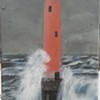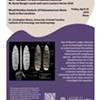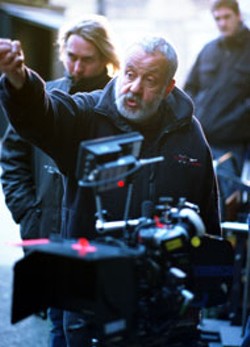Although Vera (Imelda Staunton) and her family -- husband Stan (Phil Davis) and two grown children, Sid (Daniel Mays) and Ethel (Alex Kelly) -- are living during the impoverished 1950s, they remain unflinchingly optimistic: the war is behind them; they are all gainfully employed; friends and neighbors are willing to lend a helping hand, even if, in this case, it means administering makeshift abortions. Vera is, of course, aware of the criminal consequences of her actions and thus keeps it from her family. But her motives are purely civic and neighborly, not unlike her habit of making tea for sick friends or arranging a date for a lonely young man. When her world comes crashing down in the form of a police investigation, the real tragedy, as everyone around her knows, is that Vera is neither a criminal nor an enemy of the people. She is a victim of circumstances, of two systems -- one historical and legal, the other organic and community-based -- in conflict with each other, and for which no person, or political entity, is available to rectify.
In many ways, Leigh's films themselves reflect a similar tension between the general and the specific, the historic and the individual. Overtly political, his films contain characters who often seem stand-ins for a particular political demographic -- the working-class man, the upwardly mobile professional, the social elite, the slacker, etc. Yet his method of improvisation hones and refines each character into a wholly original, three-dimensional individual. As such, Vera Drake emerges as both a tragedy of an individual woman and a portrait of an ongoing social issue.
Peter Bowen: Your films consistently reflect social reality, but rarely have they focused on a single issue, like abortion.
Mike Leigh: Actually, if you troll back through my work, you will find abortion and abortion-related issues in a lot of my films. It is part of the general business of living and dying -- of having children or not having them, and the need to have them or not have them -- which informs all of my films if you think about it.
Was this a personal issue for you?
I have never directly been involved in abortion, in the sense that I have never caused a pregnancy that needed to be terminated. But plenty of people I know have, and I am old enough to have experienced the problems of people in those situations before the laws were changed in England and Wales in 1967. On top of that, I remember when I was growing up knowing women who -- well, you know what they did, and I knew some of them had gone to prison for it.
You set the story in the period after World War II. Was that period special for you?
It was a period I absolutely lived through. I was seven in 1950 and I wanted to do a film in that postwar period in which I was a kid. I think that postwar Britain was at once a very familiar world and a very alien one. The fact is that there was a kind of innocence then. My generation, the generation of The Beatles, rejected the squeaky clean 1950s in which we grew up. Now I can see that world with understanding and sympathy, and not with 1960s teenage anger. After the war, the culture was returning to respectability, and cleanness and honesty. And somehow that innocence seemed appropriate for dealing with the situation in the film.
Your father was a doctor.
Yes, my father was a doctor and my mother was a midwife, and I would have loved to have talked to my father when I was making the film last year. But he died in 1985. He had a working-class practice, and would have had to deal with the issue of pregnancy.
What exactly were the politics of reproductive rights in the 1950s?
Throughout the film, characters refer to the Offense Against the Person Act of 1861, which made abortion illegal. There was an amendment with The Bourne Case in 1938, which allowed for psychological exemptions. It had to do with a doctor who performed an illegal abortion on a woman who had been raped by soldiers in the barracks around Buckingham Palace.
In fact, the character Susan, who is from an upper-class family, gets an abortion by having a psychiatrist deem it necessary.
Yes, but the abortion is no easier. If one says, "That is about how easy it is for a rich girl to deal with," that is true, but on the other hand, here is a girl who appears to have everything but doesn't have love or an understanding mother.
Let's talk about how you come up with a story and characters. You don't begin with a script but rather find the film's story through improvisation. Can you explain this process?
Invariably I do publish a script, but in order to make that script I sit down with a tape of the finished movie and transcribe it. A conventional script doesn't actually exist at any stage of the manufacturing process. As with all of my films, months -- in this case, six months -- are spent creating the world of the film, bringing into existence the premise of the material. The only thing that I actually put on paper is the scenario, which is about four pages and only charts the structure in a very provisional way.
How do the actors contribute?
Sequence by sequence, scene by scene, I work from improvisation. Through very rigorous rehearsals, the actors develop finely organized, scripted scenes; which is to say, they know precisely what to say and what to do in the scene, but it never goes through the conventional process of something being written first. Since the script is created through rehearsal, it is implicitly there in what they do.
In Vera Drake, what did you start with?
This particular film had a very simple and inevitable structure. There is a woman who performs abortions and who will be arrested for it. From that, the casting included everyone from nurses, judges, doctors, lawyers, etc., as well as all the central characters. But the job of bringing into existence the characters and investigating their relationships -- all that stuff -- that is what happens in the six months of creating.
How do you cast without a script or specific characters?
In this film, the only actor with whom I shared the premise was Imelda Staunton. Normally, with the exception of Topsy-Turvy, actors agree to appear in my films without any idea of what it is going to be about so that we can maintain total spontaneity during the rehearsal and do improvisations that are completely organic and truthful. The characters in the story plainly don't know the structure and don't know that Vera has been giving abortions, and they only find out when we did a massive improvisation and the cops come in. That was only one month before we shot the film.
Since this film has such a specific historical context, how did you and the others research the film?
I did a lot of research myself and had a researcher who worked on the project for a long time before we started doing it. Everybody involved then researched what they needed to know to make their characters come alive. There are guides down at the Imperial War Museum in South London who were immensely helpful to cast members in helping them construct their characters' journeys through World War II. Sometimes that research is obvious, but a lot of the stuff is hidden in the foundation.
Since this was a period piece, was it difficult getting financed?
We had a three-picture deal with StudioCanal. The producer Alain Sarde had brokered a deal. The first picture was All Or Nothing. It bombed pretty much everywhere, and so they were very reluctant to get involved with the next film, but they were contractually obliged to do so. Plainly it was going to cost more than contemporary films of mine would cost -- period films just cost more. We tried to get more money, but people were not interested. So we decided to take the risk and just be as imaginative as we could and make the film with the original budget, which was about $900,000.
How did you deal with period elements?
With the same resourcefulness that allowed us to make Topsy-Turvy for £10 million ($15 million). Like Topsy-Turvy, there was much we couldn't do, like shots you might otherwise have had of Vera walking down a main street with lots of traffic and all the rest of it. For one, period cars cost £500 a day to hire. If I had all the money in the world, would it have been better? Sure, there would have been shots of her walking down the street with lots of traffic, but finally, as with Topsy-Turvy, you say, "So what, really?" The great thing, as tough as it was, as tight-arsed as it was, was to focus on the dramatic and cinematic elements.
You also kept the production design very realistic. The apartment the Drakes lived in for example was tiny, with walls curtained off.
The truth is that people lived in these situations. In that flat where we shot the family, there was an improvised bedroom for Sid and Ethel. My sister had lived in a flat of two rooms made out of one room when we were kids, so I knew that is what it was like. Had you visited us shooting in the flat in East London, you would have been astounded at the large number of people and the camera and all that was crammed into this tiny place on the fourth floor. It was winter and nightmarish, and the guys had to schlep everything up and down. But that is what it took.
Latest in Cover
Calendar
-

Queen Charlotte Fair @ Route 29 Pavilion
-

NEW WINDOW GALLERY-Pat Rhea-ACRYLIC PAINTINGS-April 05-30 2024 VALDESE, NC 28690 @ New Window Gallery/Play It Again Records
- Through April 30, 12 p.m.
-

TheDiscountCodes
-

"Blood Residue Analysis of Paleoamerican Stone Tools in the Carolinas" @ Native American Studies Center
- Fri., April 26, 12-1 p.m.
-

Brightfire Music and Arts Festival @ GreenLife Family Farms
-
Charlotte Pride and Trans and Queer People of Color Collective clash on Pride Week priorities 2
Disagreements over representation, policing in lead-up to Pride
-
Upgrade Labs Announces Expansion Plans in Charlotte Continuing Its Tremendous Growth
-
Restaurants struggle as restrictions remain and temperatures decline 15
North Carolina restaurants that pivoted to outdoor seating are finding new challenges as winter approaches.










